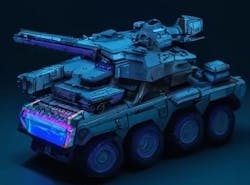How TSN Ethernet could become the next deterministic network fabric for high-performance embedded computing
THE MIL & AERO COMMENTARY – One of the biggest complaints about Ethernet as a high-speed switch fabric in high-performance embedded computing (HPEC) systems is its lack of determinism. Sure, 10- and 100-gigabit Ethernet links are fast, but it's difficult for systems designers to know exactly how fast they are. The high speed of today's Ethernet typically makes its lack of determinism irrelevant.
Previous generations of fast embedded computing required deterministic high-speed switch fabrics with names like Serial RapidIO, InfiniBand, and StarFabric. Most of those names have passed into history, except for niched applications, in favor of the latest iterations of Ethernet. The Sensor Open Systems Architecture (SOSA), in fact, requires the use of Ethernet to align to the standard and help with future compliance.
So what about those applications that require deterministic networking? Some embedded computing vendors, such as Concurrent Technologies Plc in Colchester, England, are offering Time-Sensitive Networking (TSN) Ethernet to meet the needs of hard determinism in high-speed embedded computing applications.
Nigel Forrester, director of strategy at Concurrent Technologies, outlined the company's TSN Ethernet strategy last week at the VITA the Embedded Tech Trends (ETT) 2024 conference in Fort Lauderdale, Fla.
Related: Time Sensitive Networking (TSN) & The Warfighter
TSN is an extension to the standard Ethernet protocol that enables real-time synchronization and deterministic low-latency communications by adding features for applications that need high availability, robustness, and reliability.
These features include time-aware shapers, schedulers, and guard bands that allow for deterministic and bounded communication latency. TSN also supports redundancy and failover mechanisms to ensure high availability, and includes queuing disciplines and traffic scheduling algorithms that help systems designers rank time-critical traffic on the Ethernet network in order of priority.
"TSN guarantees you can synchronize at less than 1 microsecond," Forrester told ETT attendees. He pointed out that the U.S. Department of Defense (DOD) is beginning to push for TSN Ethernet -- particularly for optionally manned fighting vehicle development. In addition to DOD, standards groups such as the Vehicular Integration for C4ISR Interoperability (VICTORY) and NATO Ground Vehicle Alliance (GVA) also are giving TSN Ethernet a hard look, Forrester says.
One major benefit of future implementations of TSN Ethernet will be to ensure the long-term availability of the switch fabric, which some refer to as "future-proofing," Forrester says. "It will be easy to deploy best-in-class capability," he says. In addition, TSN Ethernet has the potential to simplify cabling throughout aerospace and defense electronics designs.
Related: The future of high-performance embedded computing
Is TSN Ethernet a viable option for today's aerospace and defense electronics systems, or even those in the near future? Probably not, Forrester cautions. "It's decades away, but we are starting the journey," he says. Today's entry cost of TSN Ethernet is still relatively high, but over time its cost should go down as it becomes accepted, Forrester says.
To help begin the move to TSN Ethernet, Concurrent Technologies is offering two processing with TSN on the control plane, and a TSN Ethernet switch. "Our customers are asking about it," Forrester says.
Still, it's unlikely that established deterministic data networking, such as the MIL-STD-1553 and ARINC-429 avionics databus standards, will yield to TSN Ethernet any time soon. First, TSN Ethernet is much faster than 1553 or ARINC-429, and its initial use would be considered expensive overkill. "There are a lot of vendors who have spent 30-plus years developing these legacy interfaces," Forrester says.
New and existing systems designs are unlikely candidates for TSN Ethernet, but those on the horizon may find a need for such an approach. The future Northrop Grumman B-21 Raider strategic stealth bomber, and perhaps even the future Columbia-class ballistic missile submarine are likely to see implementations of TSN Ethernet.
